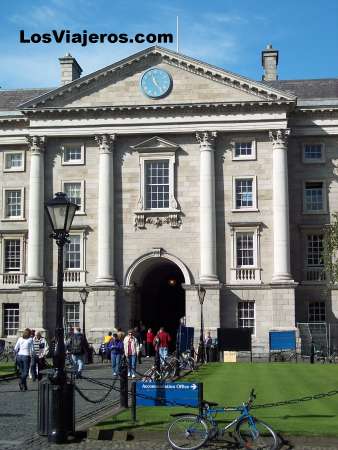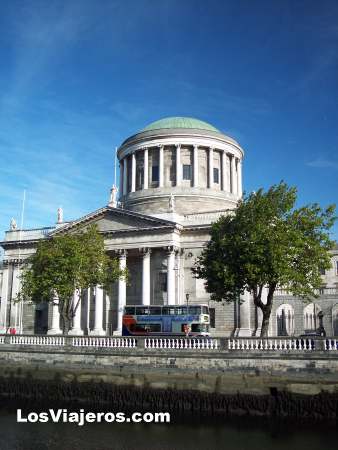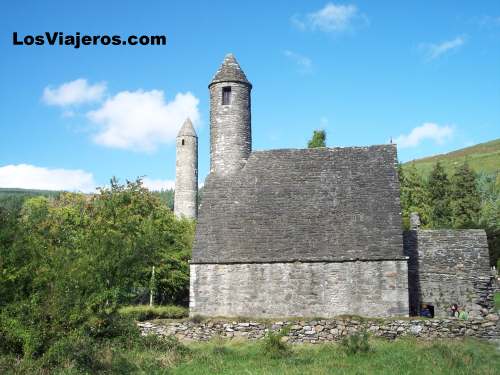Thursday, January 01, 2004 (02:00:00)
Posted by spainsun
 Photos and Text: A. De Cara
Photos and Text: A. De Cara
In this article, we are going to walk by the heart of Ireland, from Dublin to Galway, looking the main attractions of these areas: Dublin monuments, Glendalough, Wicklow, Newgrange Tombs, the green Shannon river landscape, Clonmacnoise, the scenic areas of the Burren and Connemara and finishing in the medieval city of Galway.
Dublin, one of the most elegant towns of Europe, it give travellers the best and warmest side of the polite Irish people. The most open and lively town of Ireland, with a lively nightlife is our start point in this new travel…
The country is the fastest growing economy in the European Union and Dublin, as its capital, is at the epicentre of the boom.

Dublin
It’s the main airport of the country and the better point of entrance for the continental tourism. One of the most elegant towns of Europe, it give travellers the best and warmest side of the polite Irish people.
Greater Dublin's population has swollen to 1.5 million, it means more than a third of the entire country lives here. But really Dublin doesn’t look so big, because skyscrapers or tall ugly buildings had not occupied the centre of the town. They are just some spots in the Dublin skyline.
In Downtown architecture still remains the Georgian look and shop windows has the traditional Irish style, with delightful colours.

Trinity College
Founded in 1592 by Queen Elizabeth I, the College is in a central position in the heart of Dublin. Trinity College is the oldest university in Ireland & retains some of its ancient seclusion of cobbled squares, gardens and parks.
Trinity College is famed for its great treasures: the book of Kells, a 9th century illuminated manuscript, the Books of Durrow and Armagh and an early Irish harp. These jewels are housed in the Treasury and the Long Room with over 200.000 old books more.
Georgian Architecture of Dublin
Dublin City is over a thousand years old and successive centuries have left their distinctive overlays of character and architecture, but none more strikingly than the great Georgian period of the eighteenth century.
This era was a time of peace in Ireland. The landed gentry and wealthy businessmen who controlled the country had a keen eye for fine architecture and splendid interior decoration. Dublin was remodelled to become, by the end of the century, one of the most elegant capitals in Europe. Gracious squares and terraces, wide streets and elegant public buildings gave Dublin the character which it’s retains today.
The most attractive Georgian streets are in the city south of the Liffey. Of course, in the north part of the city, there are many splendid examples of eighteenth century architecture, including the masterpiece of James Gandon - the Custom House & the Four Courts- and ensembles such as Henrietta Street, North Great George's Street and Mountjoy Square.
Temple Bar
Temple Bar is one of the city's oldest areas; the once rundown buildings in this maze of streets are today the night entertainment and eating hotspot of Dublin.
Although the term 'bar' is a reference to the single, uninterrupted drinking places, restaurants, dancing places & theatres are spread by this area. It is actually the historical term for all this riverside area.
The area is pleasant enough during the week, but on weekends can be a overcrowd place. On the western perimeter of Temple Bar is Dublin's oldest thoroughfare, Fishamble St, which was originally a Viking enclave.
Dublin Castle
Dublin Castle is the heart of historic Dublin. In fact the city gets its name from the Black Pool - 'Dubh Linn' which was on the site of the present Castle garden. The Castle stands on the ridge on a strategic site at the junction of the River Liffey.
Custom House
The Custom House was designed in neo-classic style by the renowned James Gandon and it was completed in 1791. It is one of Dublin's finest heritage buildings. It has played a important role in Dublin's social, economic and political history over the last 200 years.

Four Courts
It is other masterpieces of neo-classic style, designed by James Gandon. One of the landmarks of Dublin with its large drum and shallow dome, and visible all along the Liffey, the Four Courts derives its names from the four divisions that traditionally were the judicial system in Ireland.
Saint Patrick's Cathedral
Saint Patrick's was founded in 1191, in the site of a holy well used by St Patrick for baptisms and a church was established here as early as the late fifth century. In 1872, St Patrick's became a national cathedral for the Church of Ireland.
Christ Church Cathedral
Sitriuc, King of the Dublin Norsemen, founded the Cathedral in the year 1030. Christ Church Cathedral is one of Dublin's oldest and most recognised landmarks.
The Cathedral’s exhibition "Treasures of Christchurch" reflects 1000 years of history, architecture and worship in Ireland.
National Museum
The National Museum of Ireland on Kildare Street transports you back to 6000 BC to the 20th century.
Phoenix Park
Phoenix Park is one of the largest city parks in the world. It is a pleasant place with gardens, lakes and deer, hurling, cricket and football grounds, a motor-racing track and some fine 18th-century residences.
Near the Parkgate St entrance is Europe's tallest obelisk, the 63m Wellington Monument, a tribute to the Dublin-born Duke of Wellington.
Outside of Dublin

Glendalough (Wicklow)
St. Kevin founded this early Christian monastic site, in the 6th century. The monastic remains include a high round tower, stone churches and decorated crosses, in a glacial valley with two lakes.
The National Park which covers much of upland Wicklow and contains an area
of approximately 20,000 hectares. This includes large areas of mountain blanket bogs, as the Lugnaquilla and Liffey Head Bog complexes and Glendalough Wood Nature Reserve. The National Park provides protection for the landscape and the wildlife. This includes from rare orchids to the Peregrine Falcon.
Clonmacnoise (Offaly)
This early Christian site founded by Saint Ciaran in the 6th century on the banks of the River Shannon, includes the ruins of a cathedral, eight churches (10th-13th century), two round towers, some high crosses and a large collection of early Christian grave slabs. The original high crosses and grave slabs are on display in the Visitor Centre.
Galway
Galway is an old city, a county and a door of entrance to the scenic areas of Burren in the south and Connemara in the north and the Aran Islands. There is certain chemistry to this friendly University City. Music, festivals, horse racing, pubs, restaurants, shops, theatres and most of all Galway people, combine to create this atmospheric mediaeval city of culture. From this pulsating heart the rest of the county flows. Galway Bay its beauty unchanging.
Scenic Irish areas include mountains, castles and stone walls, banks of turf, long sandy beaches, clear lakes and flowing rivers. The surrounding countryside has pretty villages, and traditional pubs.
The Burren
The Burren (Clare County) is a paradise for geologists, botanists, ornithologist, speleologist and archaeologists.
The Region's extraordinary rock formations, spreading over 500 sq km. Formed some 340 million years ago at the bottom of a warm, shallow sea, the visibly fossil-rich layers of limestone that characterise the Burren have been modified by millions of years of glacial, tectonic and human processes.
Connemara
Connemara, Galway's West Coast, boasts beautiful mountains, bogs, lakes and coastal landscapes. The capital of this stunning area is the small town of Clifden. North of the Galway-Clifden road, the tall quartzite domes and cones of the Twelve Bens rise steeply, while other mountains, formed of schist and gneiss, continue the highlands northward to the beautiful Killary fjord.
Newgrange Tomb
Newgrange (County Meath) is the most famous of all Irish prehistoric sites. It is known as a passage tomb. Originally built c. 3200 BC, it lay lost for centuries until the late 17th century. It consists of a vast man-made stone and turf mound retained within a circle of huge kerbstones topped by a high inward-leaning wall of white quartz. A long passage leads to a cross-shaped chamber under the mound. Every year, at the time of the winter solstice, the sun shines directly along this passage into the chamber for about 15 minutes as it rises.
For more pictures: https://www.losviajeros.com/fotos/europa/irlanda
Hotels in Dublin:
El Hotel Regency North Star was our hotel in Dublin, confortable with a charming restaurant, sited in the center od the town.
http://www.regencyhotels.com
Our Gratefuls to the Ireland Tourism Office:
http://www.ireland.ie/
http://www.failteireland.ie/
